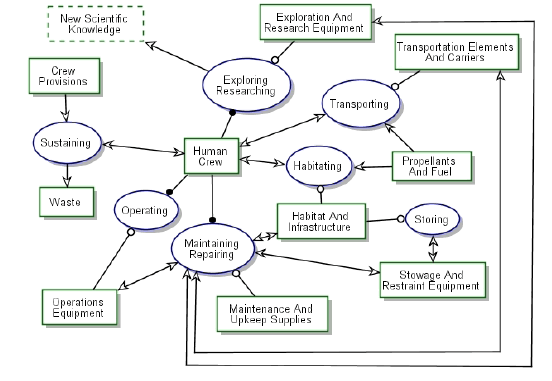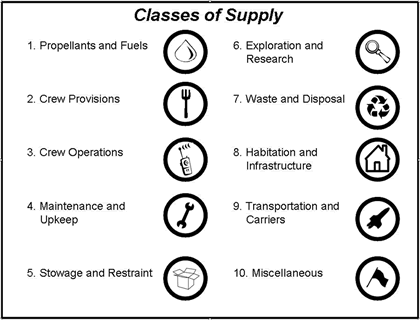Classes of Supply for Exploration Logistics
For this project, a new formulation of Classes of Supply (COS) was required due to the non-existence of any scheme that would have been suitable for interplanetary exploration logistics. The COS of several organizations that carry out extensive logistical operations in remote locations such as NATO, the U.S. Military, and NASA (for ISS) were initially analyzed to determine if any would be suitable for our use. It was found that the classification schemes employed by those organizations did not have a uniform way of categorizing the items in the supply chain, and were customized for their particular needs. Even the most closely related COS, the Cargo Category Allocation Rates Table (CCART) used for ISS, had several deficiencies when exploration logistics in a larger context were considered. For instance, there are no categories in CCART that would allow for classifying propellants, habitation infrastructure, or surface exploration equipment.
Functional Based COS
A new function-based generic COS classification was therefore formulated (see figure below) that would serve the requirements of an interplanetary exploration supply chain. The processes (functions) involved in an exploration enterprise were first identified, followed by their associated objects.

Object-Process Diagram of a Generic Exploration System
In the figure above ovals represent processes (functions), while rectangles identify objects. Objects and processes are linked via affectee, consumee, resultee, and agent or instrument links. Specifically, the human crew explores and researches sites of interest to generate new scientific knowledge. This requires that the crew be transported there with transportation elements (vehicles and carriers), which causes consumption of propellants and fuels. Exploration and research equipment facilitates the process of exploring and researching. During the entire time the human crew must be sustained with various crew provisions (water, gases, food, medical supplies…) which produces waste. For longer durations the crew must be sheltered in a habitat or larger ground infrastructure which often also consumes energy in the form of fuel. Inside this infrastructure provisions must be made for stowage/storage and restraint of various supply items. Operations equipment is required to allow the crew to communicate with the outside world, as well as properly monitor and control all systems on base. These systems must all be maintained preventatively or repaired in the case of failures to ensure safe and efficient operations of the exploration system. Based on this analysis, a set of ten classes of supply was formulated, representing a high level grouping of the primary objects used in the exploration system.

10 COS for Exploration Logistics
Each of the ten classes has several sub-classes which further refine the categorization of the supply items. By assigning each item to a supply class and a sub-class, we allow a flexible multi-level supply class hierarchy which can give us great flexibility in dealing with supply classes at different levels of granularity. The first step of validation of this classification was carried out by mapping the COS against the current taxonomy used by NATO, the U.S. Military and the International Space Station (CCART). The second step of validation was via the HMP expedition, which allowed us to validate the functional view of exploration supply classes and ensured that we did not forget a major class of supply. Physically recording a detailed inventory also forced us to generate a total of 44 sub-classes that were complete, nonoverlapping and reflective of the physical reality encountered at the HMP research station.
